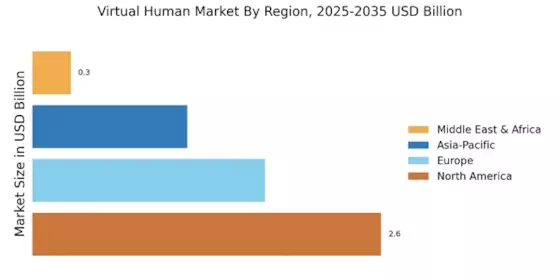The Virtual Human Market is currently characterized by a dynamic competitive landscape, driven by rapid technological advancements and increasing demand for immersive digital experiences. Key players such as NVIDIA (US), Epic Games (US), and Meta Platforms (US) are at the forefront, each adopting distinct strategies to enhance their market positioning. NVIDIA (US) focuses on leveraging its powerful graphics processing units (GPUs) to facilitate realistic virtual human interactions, while Epic Games (US) emphasizes the development of its Unreal Engine to create lifelike avatars and environments. Meta Platforms (US), on the other hand, is heavily investing in social virtual reality experiences, aiming to integrate virtual humans into its metaverse vision. Collectively, these strategies not only intensify competition but also foster innovation, pushing the boundaries of what virtual humans can achieve in various sectors, including gaming, entertainment, and customer service.
In terms of business tactics, companies are increasingly localizing their operations and optimizing supply chains to enhance efficiency and responsiveness to market demands. The competitive structure of the Virtual Human Market appears moderately fragmented, with several players vying for dominance. However, the influence of major companies like Microsoft (US) and Google (US) cannot be understated, as their extensive resources and technological capabilities allow them to shape market trends and consumer expectations significantly.
In September 2025, Microsoft (US) announced a strategic partnership with Soul Machines (NZ) to integrate advanced AI-driven virtual humans into its Azure cloud services. This collaboration is poised to enhance customer engagement through personalized virtual assistants, indicating a shift towards more interactive and responsive digital interfaces. The strategic importance of this partnership lies in its potential to redefine customer service paradigms, making interactions more human-like and efficient.
In August 2025, Epic Games (US) unveiled a new initiative aimed at democratizing access to its Unreal Engine for educational institutions. This move is designed to foster creativity and innovation among students, potentially cultivating the next generation of developers in the virtual human space. By investing in education, Epic Games (US) not only strengthens its brand loyalty but also ensures a steady pipeline of talent that could drive future advancements in virtual human technology.
In July 2025, Meta Platforms (US) launched a new suite of tools for developers to create more sophisticated virtual human avatars within its metaverse ecosystem. This initiative reflects Meta's commitment to enhancing user experience and engagement, as it seeks to establish itself as a leader in the burgeoning metaverse market. The strategic importance of this launch lies in its potential to attract more developers and users, thereby solidifying Meta's position in the competitive landscape.
As of October 2025, the Virtual Human Market is witnessing trends that emphasize digitalization, sustainability, and the integration of artificial intelligence. Strategic alliances among key players are increasingly shaping the competitive landscape, fostering innovation and collaboration. Looking ahead, it is likely that competitive differentiation will evolve, with a pronounced shift from price-based competition to a focus on innovation, technological advancements, and supply chain reliability. Companies that can effectively leverage these trends will likely emerge as leaders in the Virtual Human Market.


















Leave a Comment